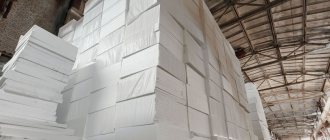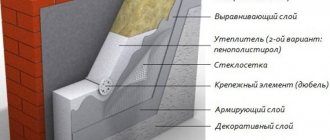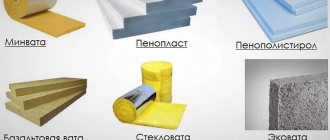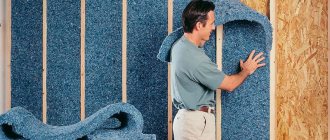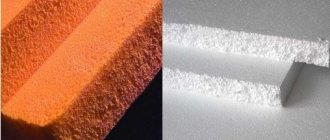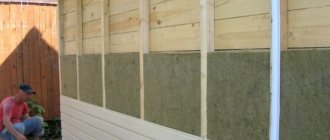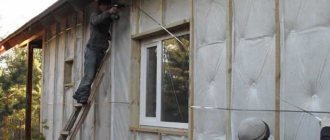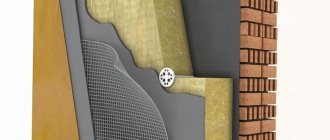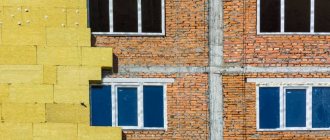One of the fastest and most practical ways to insulate a house is to cover it with foam plastic. Polystyrene foam (expanded polystyrene) has long established itself as a good insulation material. This material is the most affordable in terms of price and availability in stores and is considered one of the best solutions for facades in terms of price-quality ratio. In this article we will look at how to properly insulate a facade with polystyrene foam, its main characteristics (density, thickness), point out the main mistakes and watch a video with step-by-step instructions on the technology of insulating the walls of a house with your own hands.
How to properly insulate a house with foam plastic from the outside
Everyone knows that a significant percentage of heat loss occurs on the walls of the house, especially if they are not insulated. In this case, even a modern and efficient heating system will not cope with high-quality heating of the room. If you know how to insulate the outside of a house with foam plastic with your own hands, you can save a lot and not need to hire a specialist.
Advantages of external wall insulation with foam plastic
Insulating a house from the outside can be done in two ways: outside and inside. Experts advise carrying out work from the street side, in this case:
- the usable space of the house is preserved;
- there is no need to perform an additional layer of vapor barrier;
- a multilayer structure is provided that prevents moisture from entering the room;
- the heat-saving properties of the house increase, which allows you to save money by reducing heating costs.
Which polystyrene foam is better to insulate a house?
You may be wondering whether it is possible to insulate a wooden house with polystyrene foam, and also how much such insulation costs. Wooden houses, just like ordinary ones, need insulation. The heat will quickly escape through the timber, which means the house will become uninhabitable in the winter. The price of insulation depends on the size of the house, as well as which company you use. You can save money by insulating the outside of your home yourself.
How to choose polystyrene foam for cladding a house? For insulating facade work, the best option is foam in the form of sheets, the thickness of which is at least 10 cm. Knowing how thick the foam is to insulate the outside and inside, you can achieve good results and save on heating your home.
There are 2 types of foam:
- Fragile. This material breaks and crumbles easily.
- Building. It is very dense, but at the same time light. It cannot be pushed.
Both types are excellent for insulation work: the denser one retains heat well, while the porous one can withstand distortions and is cheaper.
Find out how to insulate the walls of aerated concrete houses
Positive properties of polystyrene foam for external insulation
- ease of use, easy attachment to the surface;
- affordable price;
- seismic resistance;
- not subject to rotting;
- high heat-saving characteristics.
The disadvantages of foam insulation are as follows:
- It is an artificial material, so environmental friendliness is questionable.
- Flammable.
- During the combustion process, harmful substances are released;
- Mice really liked it as a place to live.
Step-by-step instructions for insulating the exterior of a house on your own
It will be useful at work:
- sheet foam;
- fasteners;
- assembly adhesive;
- reinforced mesh;
- putty;
- primer;
- drill;
- sharp knife;
- spatulas;
- hammer.
Step 2: preparing the walls
Step 3: foam installation
If the outside wall of the house has been properly prepared, then the process of gluing the foam sheets will take a little time. The glue is applied to the sheet using a spatula, the excess is removed with a notched spatula. Additionally, glue is applied to the wall surface. A sheet of foam plastic is carefully applied to the wall and lightly tapped to secure it.
Step 4: fixation with nails
The external surface of the house is left for 3 days for the glue to dry, after which it is secured with special type of nails. They are hammered along the edges and, for reliability, one in the center.
Step 5: Gluing the mesh
A layer of glue is applied to the foam, then a mesh is applied. Using a spatula, you need to smooth it out and add adhesive if necessary. First, the mesh is stretched over the corners, then distributed over the entire surface. From the edge you need to leave 10 cm of mesh without glue, for joining with the next layer. When the surface dries, sand it down and apply finishing putty or decorative plaster on top.
As you can see, the technology for insulating the facade of an ordinary or log house with polystyrene foam is simple, and if carried out correctly it will give tangible results. Now you know how to carry out external insulation of a house with polystyrene foam with your own hands and you can decide for yourself whether it is worth insulating with this material or not.
Myth 4: A facade insulated with foam plastic “does not breathe”
Against the background of high-quality wall insulation with a high degree of heat retention, foam plastic demonstrates low water and vapor permeability. However, this is both its advantage and its disadvantage at the same time. During installation, it does not require additional moisture-proofing agents - membranes and films. It itself prevents water from entering the building.
Polystyrene foam does not allow moisture to pass through, but it also cannot accumulate it. The steam escaping from the rooms of the building gets out through the unevenness and gaps of the material. This provides the necessary “breathing”.
Features of the heat insulator
The production of penoplex for wall insulation includes the following technological operations:
- Granules of the material are loaded into an extruder, where they are heated to 130-140°C;
- Foaming agents – porophores – are added to the portion;
- The thickened mass is squeezed out of the extruder onto a conveyor belt, after which it is cut into dimensional slabs;
The mixture of semi-finished penoplex for external wall insulation consists not only of polystyrene foam and foaming agents - it also contains antioxidants designed to prevent thermal oxidation during processing and damage to the integrity of the insulation during operation, fire retardants to increase fire resistance, as well as antistatic, light-stabilizing and modifying additives that protect thermal insulation material from the influence of external factors.
The main positive parameters of the material:
- Low moisture absorption of expanded polystyrene is the main advantage;
- The minimum coefficient of thermal conductivity, which allows, when calculating the thickness, to choose thin slabs;
- High vapor permeability of penoplex: a 20 mm thick slab replaces one layer of roofing material, but at the same time also insulates the working surface;
- High compressive strength and other mechanical loads. The extrusion method in the production of thermal insulation allows the cells of the material to be evenly distributed, improving the quality of density and strength;
- Easy and quick installation of insulation due to its low weight and good density;
- Long service life of extruded foam – up to 50 years;
- Excellent sound insulation and minimal chemical activity.
Penoplex size range:
- Slab length – from 120 to 240 cm;
- Slab width – 60 cm;
- Thickness – from 2.0 to 12.0 cm.
Disadvantages of extruded foam:
- Flammability of groups G3-G4, formation of toxic smoke during fire;
- Polymer additives in the composition of the material can evaporate toxic substances when exposed to sunlight. Therefore, the optimal use of penoplex is external, for example, insulation of brickwork;
- Petroleum products and some organic substances can deform penoplex, the thickness of which can be any. These are substances such as: formaldehyde and formalin, acetone and methyl ethyl ketone; liquids containing ethyl, benzene components, polyester resins, synthetic paints and fuels and lubricants.
Thermal conductivity properties determine the quality of penoplex insulation. The higher the thermal conductivity coefficient, the fewer centimeters the layer of insulating material will be. Laying the insulator from the inside or outside depends on the characteristics of vapor permeability and strength (density). You can compare the parameters of popular materials for insulating floors and other surfaces by studying the data in the table:
From the table it is clear that foam plastic thermal insulation has an average thermal conductivity value, which is slightly less than that of polyurethane foam, mastics and roll materials. But you can choose penoplex only because the layer of such liquid insulation does not have joints and seams, like slab insulation, no matter how many layers are applied to the surface.
Myth 11: The higher the density of the foam, the warmer it is.
The density of a foam plastic cellular mass is an indicator that reflects the ratio of the weight of the material to its volume. Thermal conductivity, strength, water resistance, and other performance characteristics depend on this value.
The greater the density, the more closely the individual cells are adjacent to each other. Heat from one to another will be transferred faster. Therefore, the thickness of the foam for wall insulation is important.
The less gas inside, the greater the heat loss, so for wall insulation it is better to use lightweight material with large cells.
What is better to insulate with mineral wool?
- For wooden houses you don’t have to choose which is better - polystyrene foam or mineral wool. “Breathing” wooden walls cannot be insulated with foam plastic - this will negate their beneficial properties. Therefore, they are insulated with mineral wool. And in buildings built from other materials, partitions, floors, ceilings, and ceilings are sheathed with mineral wool. If external walls are insulated, then a ventilated façade of a suspended type is made. Vapor barrier membranes are an integral part of this design.
- Mineral wool is used to insulate attics, attics and floors of houses, and pitched roofs. At the same time, be sure to leave space for ventilation.
- Brick houses with a small number of floors, in which the middle thermal insulation layer is mineral wool. It is also used for three-layer panels made of concrete, reinforced concrete, as well as sandwich panels in a metal shell.
- They are used in places where it is necessary to provide good protection from very hot objects, since basalt wool can withstand temperatures up to 1000 0C.
- Frame buildings of any type are best insulated with mineral wool. In addition, it is also used for sound insulation. Moreover, this material is well suited for horizontal, vertical, and curved surfaces.
- Mineral fiber wool, produced in the form of soft slabs, can be used to wrap heat, water and gas pipes. It is also used to insulate industrial equipment in enterprises.
Application area
When insulating a house from the inside, it is necessary to increase the thermal insulation of the following structures:
- in the construction of the basement floor on the ground, if the underground floor is heated;
- in the floor pie of the first floor when installing a cold basement or underground;
- exterior walls;
- ceiling above the top floor when installing a cold attic;
- covering when installing a warm attic;
- attic roof.
Of all these parts, polystyrene foam for home insulation is best used in wall construction. In floors, foam plastic should only be used in conjunction with joists, which will take the main load from the floor, furniture, etc. The thing is that the density of polystyrene foam does not allow it to withstand high compressive loads.
Floors with foam plastic without joists can be used for technical purposes - attic floors, etc. Therefore, if you want to efficiently insulate the floor under the screed, the best insulation option is extruded polystyrene foam. The insulation on top should cover a layer of cement-sand screed 50 mm thick with additional reinforcement. For reinforcement, a mesh of reinforcement with a diameter of 3-4 mm is used.
Another area of application of foam plastic is the production of permanent formwork for concreting. This insulation is used in the construction of strip foundations. Allows you to reduce the number of stages of work on pouring a monolith at home and at the same time perform thermal insulation of the structure. Reliable waterproofing must be provided on top of polystyrene foam.
Preparatory work
Insulating the facade with foam plastic begins with preparing the walls. Let's immediately say when it is better to start work - in the warm period of time. But the most important indicator is the humidity of the walls. They must be dry. After the rain, it is advisable to wait a week for dry, preferably windy, weather. After that you can start.
Preparation of external walls
Preparation for insulating the facade with polystyrene foam begins with cleaning everything that flakes and falls off. If the walls were covered with paint, it is removed, the lime is cleaned off. If there are swollen areas of plaster or tiles, they will be resurfaced. Only what holds tightly should remain.
You need to clean everything that can fall
Then it’s time to level the walls. It is very good if the insulation boards lie on the wall with their entire surface, without voids. But such walls are the exception rather than the rule, therefore unevenness of about 1 cm per square meter is acceptable. Protrusions and holes that are large in depth/height must be leveled - filled with plaster mortar (pre-primed) or cut off. The smoother the surface, the easier the work will be.
To prime or not
There is no need to prime only those walls; running your hand over them will leave your palm clean. If there are white marks, pieces of plaster, sand, etc., it is better to prime it. This will ensure better contact of the glue with the wall. The operation takes little time, is simple, requires little money, and has great benefits. So if you are doing the insulation of the facade with foam plastic or EPS “for yourself”, it is better to prime it.
Priming is a simple process, but very useful.
Any primer is suitable for facade work. Normal companies are Ceresit, Master, Stolit, Kreisel, Tokan, Ekomix. The primer is diluted or not, depending on the release form and instructions, applied with a brush or spray. Spraying is faster and easier, but using a brush is better.
Preparation of EPPS
If you decide to insulate the walls outside with expanded polystyrene (EPS), its surface must be made not so smooth. Polystyrene foam has a looser structure and does not require preliminary preparation. You need to make scratches on the surface of the EPS, otherwise it will fall off from the glue.
Tools for preparing EPS
Take a spiked roller, which is used to process drywall, and roll it well in all directions. The second way is to take a brush with metal bristles and make grooves with it. Softer methods don't work. The work is not hard, but it takes a lot of time. This must be done before you begin installing polystyrene foam on the walls. If the insulation is laid in two layers, it is necessary to process the sheets for both layers.
Finishing window sills, slopes, ebb
It is better to install all elements - window sills, slopes and ebb (drip) before installing the insulation on the walls. When installing, you need to remember that you will still have a significant thickness of insulation + finishing. If window sills and slopes have already been installed, they will have to be replaced - they will be too short. In order for everything to look organic and fit easily into the insulating pie, the elements must have the following dimensions:
- The window sill should protrude beyond the plane of the wall by 3-4 cm (more or less is not necessary). If the insulation thickness is 60mm, you will need a window sill 100-110mm deep (60mm insulation, 10mm finish, 30-40mm overhang). When installing a window sill, all voids must be filled. You can lay thermal insulation plates, fill the gaps with polyurethane foam and lay a window sill on top of it all, load it with something heavy and leave it for 3-4 hours.
- When separating the slopes, they should protrude beyond the plane of the existing wall (without insulation) by 1 cm. This will make it easier to connect it with the insulation. They sit it on glue (the same one that will be used when insulating the facade with foam plastic). There is another subtlety here: finishing the slopes requires insulation of a smaller thickness - 20-30 mm maximum. The thicker one will simply “climb” onto the glass (don’t forget about the presence of finishing layers, leave about 10 mm on them).
- Between the base and the insulation, a drip line is installed (also called a “drip cap”). This is a strip of galvanized steel with powder paint. It is mounted on the base with self-tapping screws or dowels (depending on the material of the base) in increments of 20 cm. Sold in pieces of two meters, during installation one piece overlaps the other by 10-15 cm. The ebb is necessary so that water flowing down the wall does not flow into the house, and merged into the street.
As you can see, the preparatory work before insulating the facade with foam plastic (polystyrene) also takes time. They are not complicated, but have a significant impact on the overall result.
Preparation
The entire wall surface must be prepared. So, all debris and any protruding elements are removed. The surface is cleaned of everything that crumbles. The preparatory stage also includes repairing the seams between the bricks.
If there are cracks in the concrete wall, they need to be repaired. The base must be impregnated with Aquastop. For maximum effect, the entire working part is treated with deep penetration primers.
Answers from experts
Engineer:
Both brick and foam are different.
Formally, the thermal conductivity of red brick is 10 times greater than that of highly porous foam. (0.56 and 0.05 W/m*deg - respectively)
That is, feel free to multiply the thickness of the foam by 11 and get the thickness of the brick wall.
Kirill Gribkov:
none
Bolt-gnawer:
Extruded polystyrene foam "Extraplex" with a thickness of 20 mm is equivalent in its heat and sound insulating properties to a brick wall with a thickness of 370 mm
Samson Altunyan:
Hello, the best!
You forgot to mention the conditions (parameters) of the assessment...
1) If you mean thermal conductivity? . The engineer answered you.
2) If we are talking about mechanical strength? . Polystyrene foam is NOT a replacement for brick. Especially in earthquake-prone regions.
3) Durability? The brick will last longer.
4) Resistance to environmental influences (temperature changes, humidity, etc.)? Foam plastic, in this case, is not even a building material...
5) Safety (physiological, chemical, environmental)?..Again, the comparison will be in favor of fired clay (brick)...
And generally speaking.. . That's not what they teach you... ;-( Foam plastic is NOT a good choice of material for construction or interior decoration. And in this ODIN is absolutely right...
Good luck to you!
Nurgaliev Marat:
5 cm of penoplex is half a meter of brick!!! And don't listen to the reindeer herders!
kukuzya:
I read the answers and I'm confused. What kind of tusk do you need to be in order to answer the question about the equivalence of brick and foam plastic and compare their load-bearing abilities... Of course, they compare thermal conductivity...
ST:
10cm of foam replaces 50cm of brick
Lulechka:
thickness is the same. in terms of strength, thermal insulation and other qualities - this is for builders!!!
Igor Chekalin:
Considering the beginning of winter, I suspect that we are talking about thermal conductivity?
Is the brick hollow or solid, silicate, ceramic, silica or even slag? The difference between different types is almost two times, and with silica it is 5 times.
For the worst case - solid sand-lime brick - the thickness ratio is approximately 20 times. That is, in terms of thermal conductivity, a 250mm wall (ordinary one-brick masonry) corresponds to only 13mm of polystyrene foam. For hollow bricks the ratio is ~10 times. That is, in our case - ~25mm foam. However, brickwork is almost airtight, and when insulated with foam plastic, there are gaps at the joints, loose edges, etc., so it’s not entirely correct to take such a formal and mathematical approach.
Well, more accurate numbers - google for “thermal conductivity table of building materials”
Alexander Kulikov:
The thickness of your knowledge of the Russian language...
Albert Belkov:
In fact: 1 cm of foam plastic in terms of thermal conductivity can be estimated as half a brick inside the masonry or backfill.
ST:
10cm of foam replaces 50cm of brick
Thickness
Foam thickness is a parameter that should be chosen based on an individual set of factors: wall thickness, wall material, climatic conditions, etc. That is why it is impossible to say that a 5 cm thick layer of polystyrene foam is suitable for absolutely everyone, although this is the material most often used for insulating apartment buildings in the temperate zone.
Everyone will be able to calculate the required insulation thickness using the tables below. So, let's say you live in a house whose walls consist of two rows of bricks. The heat transfer resistance will be 0.405 m²*°C/W. Considering that the thickness of the walls is 54 cm. Moreover, the standard value, for example, for Moscow is 3.16 m 2 * 0 C/W, the difference is 2.755 m²*C/W, and this is exactly what needs to be compensated for with insulation, the thermal conductivity of which in our case 0.031 W/m*°C. It turns out that the thickness of the insulation will be equal to 0.031 * 2.755 = 0.085 m, which is 8.5 cm.
Classes and grades of foam plastic
Foam classes
There are only two classes of foam: pressed and non-pressed. From the names it is clear that these materials have different production methods. The first is made using pressing equipment, the second - by sintering at high temperatures. But this production line also uses pressing equipment. However, the classification is what it is.
Expanded polystyrene suspension pressless
Which class the foam belongs to can be determined visually. Bespressovy is a complex of fairly firmly glued round and oval granules. The structure of this material is porous, the strength depends on the density.
Pressed polystyrene foam
Pressed sheet has the appearance of a fairly smooth sheet, the density of which varies and depends on the brand of the product. This material has excellent technical and performance characteristics.
Foam brands
Foam brands
Polystyrene foam produced using the non-press method is designated by the abbreviation PSB. Press - PS. The product name may also contain other letters, each of which indicates a feature of this product.
- A – the canvas has the correct geometric shape of a parallelepiped and a smooth edge;
- B – the edge of the product has an L-shaped cut;
- P – cutting of the blades is done with a hot string;
- F - façade or made using special forms;
- C – self-extinguishing;
- N – the product is suitable for external use.
The numbers in the name of the PPP indicate its density.
Brands of pressless foam
PSB-15
The most inexpensive product with a high degree of fragility. Used as a thermal insulation and packaging material, it crumbles easily and has low hygroscopicity. Traditionally used for insulating balconies and loggias, country houses, containers and outbuildings.
Foam plastic PSB S-15
PSB-25
Foam plastic of different brands
This brand of foam plastic is often supplemented with the letter “F”, so the material is recommended for insulating facades. Due to its higher density than PSB-15, it is used for the manufacture of landscape and interior decorative elements.
PSB-35
Expanded polystyrene PSB-S-35
A universal material with a wide range of applications. It is used for insulation of utilities, heat and gas mains, production equipment, thermal insulation of roofs and attics. Involved in the production of multilayer panels (including reinforced concrete) as a thermal insulation gasket.
PSB-50
Characteristics of polystyrene foam PSB-S 50
This material has the highest density among non-press foams. Demanded as a heat and sound insulator for objects of any purpose. It is able to provide high-quality protection from the cold, therefore it is used in the construction of underground communications, garages and parking lots, and in road construction.
Characteristics of brands of pressless foam.
| Index | PSB-15 | PSB-25 | PSB-35 | PSB-50 |
| Compressive strength at 10% strain (MPa) | 0,04 | 0,08 | 0,14 | 0,18 |
| Density (kg/m3) | 15,0 | 15,1-25,0 | 25,1-35,0 | 35,1-50,0 |
| Thermal conductivity (W/mK) | 0,1 | 0,43 | 0,38 | 0,38 |
| Water absorption during the day in% of the total volume | 4 | 3 | 2 | 2 |
Pressed foam brands
Durable and rigid press (tile) foam is a closed-cell plastic. It is a radiotransparent material. It has found wide application in all sectors of industry and agriculture. PVC foams, which contain polyvinyl chloride resin, are produced using the pressing method.
Brands PS-1, PS-2, PS-3, PS-4.
They have a closed-porous structure, the degree of hygroscopicity is close to 0. They are extremely resistant to atmospheric influences. Self-extinguishing, petrol and oil resistant.
High-hardness foam PS-1-350
PS-1-150
They are used in radio electronics as a material that is unstable to electrical breakdown, as well as for the manufacture of containers and floats for aggressive liquids.
For insulation of building facades, pressless foam plastics of different densities are in demand. In order to buy truly high-quality material, you need to know how you can independently check the information of the manufacturer and seller.
Polystyrene foam of increased hardness PS-4-40
Among the largest Russian producers of foam plastic are the following companies:
- "Styroplast" (Chekhov);
- "Omegaplast" (Moscow);
- "Gamma Center" (Kolomna);
- "Kavminprom" (Mineralnye Vody);
- "Stavpolyester" (Stavropol);
- "Rosplast" (Moscow).
Technology 1 frame construction
Features of the technology
Frame construction is far from a new technology. However, in our country it has become widespread only in the last two decades.
The essence of this technology is to build a house frame from wooden beams. In this case, the space of the frame is filled with foam plastic. On the outside, such walls are sheathed with OSB boards, and on the inside with plasterboard, clapboard or other finishing material.
Thus, foam plastic in this case serves as a wall filler, responsible for wall insulation and sound insulation.
Advantages and disadvantages
We will not go into details of the frame construction technology itself, since it has already been discussed several times on the pages of our portal. Therefore, further I will only talk about the pros and cons of insulating a frame house with foam plastic.
Advantages:
- Efficiency.
Due to the low thermal conductivity of polystyrene foam, in central Russia a thickness of 150-200 mm of insulation layer is sufficient. The housing will be warm and energy-saving; - Economy.
Foam plastic is one of the cheapest materials that can be used in frame construction;
- Environmental friendliness.
This material is hypoallergenic and does not cause irritation upon contact with the skin, unlike mineral insulation. Therefore, it is comfortable to work with him; - Shape stability.
Polystyrene foam does not shrink, which eliminates the appearance of cold bridges in the walls; - Durability.
If the insulation technology is followed, the material will last more than 50 years.
Flaws:
Zero vapor permeability. For this reason, the walls from the inside need sealed vapor-waterproofing. Otherwise, all the moisture will accumulate in the joints between the wooden frame parts and polystyrene foam, which will lead to rotting of the frame. Water vapor barrier, in turn, turns the home into a sealed “thermos”. Therefore, such buildings require high-quality ventilation;
Fire hazard. Polystyrene foam manufacturers very rarely add fire retardants to their composition. As a result, the material burns well and at the same time releases dangerous toxic substances.
For these reasons, foam plastic is rarely used to insulate a frame-type house. Mineral wool is most often used.
It must be said that instead of polystyrene foam, you can also use penoplex in a frame house. This material is an improved version of polystyrene foam.
Penoplex is more effective in terms of thermal insulation, and is also stronger and more durable. In addition, penoplex usually contains fire retardants, which makes it a low-flammable material.
The disadvantage of penoplex is its low vapor permeability. In addition, the price of penoplex is 2-3 times higher than that of polystyrene foam.
Which polystyrene foam is best to use for insulation?
Foamed granular plastic material, which is light due to the presence of air bubbles in the cells - this is foam plastic. It has good thermal insulation properties and is a good sound insulator. It is easy to install, as it is available in slabs of a certain size and thickness.
Due to the fragility of the material, its installation should be done carefully. Polystyrene foam is non-toxic, but when burned it can release caustic and highly toxic substances. Polystyrene foam is characterized as an unsuitable material for rodents to live in, however, the passages that mice can leave can cause the formation of cold bridges
Polystyrene foam is classified into the following grades depending on the production method:
- polystyrene. Can be manufactured using press or non-press methods. Pressless is designated PSB. PSB-S - self-extinguishing. The numbers in the name indicate the degree of density: 15, 25, 35, 50. Extruded foam plastic (penoplex), which has fewer air cavities in the structure and is more uniform, is very popular when insulating facades;
- polyurethane. Designated as PPU. Reminiscent of a sponge: the material is characterized by an abundance of air pores and is soft. Easily deformed, destroyed by exposure to the sun, short-lived. Used in the furniture industry, household appliances and various areas of production;
- polyvinyl chloride. Designated as PVC. Elastic, non-toxic material. Toxicity, or more precisely hydrogen chloride, can be released in the event of a fire that occurs during the combustion of surrounding materials;
- polyethylene. Designated as PPE. It is a flexible translucent sheet. Can be of different thickness. Used to protect new household appliances, dishes and other products from mechanical damage.
Types of foam
There are other types of foam: urea-formaldehyde, phenol-formaldehyde and others, which are not as popular as the above.
The most suitable type of foam for outdoor installation is the polystyrene type.
If you choose by production method (extruded or foamed), then, based on the fact that extruded foam has high vapor-tight properties, it is more demanding in installation. To accurately determine the dew point, you should carefully calculate the thickness of the insulating layer. Due to its smooth surface, it is necessary to resort to installing a metallized mesh. In this regard, installation of extruded foam is more complicated and financially more expensive.
IMPORTANT! Foamed polyurethane foam (PSB) is perhaps the most suitable type for facade work. The best option is PSB-S-25.. Characteristics of PSB:
Characteristics of PSB:
- easy;
- environmentally friendly;
- waterproof;
- vapor-tight;
- durable;
- does not rot;
- unsuitable for rodents;
- resistant to loads;
- flame retardant.
In addition, the material is resistant to water and some types of chemicals.
Foam insulation
Slab size
Foam boards are produced mainly in three sizes: 0.5 * 1, 1 * 1 and 2 * 1 m. It is immediately worth noting that this insulation is easy to cut, so no problems should arise during the installation process. So, it is better to choose the material that is most suitable for the area of the insulated surface. As a rule, for insulating balconies, loggias and apartments in apartment buildings, the choice is made on slabs measuring 0.5 * 1 m : they are most convenient to work with, they are more economical, and it will be easier to insulate all kinds of complex facade details with such material. But if you need to insulate a private house, the walls of which have a regular flat surface, then it makes sense to use slabs measuring 1 * 1 m. The largest material, slabs measuring 2 * 1 m are used least often for particularly large buildings.
Fastening methods
The most popular methods of attaching foam sheets are:
- on polyurethane foam;
- with special glue.
Polyurethane foam
This method ensures reliable fastening of the material to the base. The foam layer creates additional thermal insulation. The foam does not need to be diluted; it is easily and quickly applied. Exactly as much foam comes out of the gun as measured by pressing the trigger; there is no need to mix it and monitor the expiration date of the solution. The disadvantage of the method is the high cost of the material. If you need to insulate a small area of the facade, then polyurethane foam is the best solution.
Glue
Fastening with glue, when used correctly and following the technology, gives strength comparable to polyurethane foam. This method requires more thorough surface preparation and is more labor intensive per unit area. The glue will have to be mixed periodically, making sure that you have time to use it - the shelf life of the solution is limited to 2-4 hours, depending on the brand.
How to fix a faucet with a cartridge
Most often, faucets with one lever are installed in the bathroom or kitchen. They are also called flag or single-lever. A special device, a cartridge, is responsible for opening/closing the water in it, which is why they are also called cartridge ones.
There are two plates with holes inside the cartridge. The lower one is fixed rigidly, and the upper one is movable. A rod is attached to it, and it, in turn, is attached to the handle. By turning the handle, we move the rod, and it moves the movable plate, which opens/closes the water and changes its pressure.
If there are problems with such a faucet, it can only be repaired by replacing the cartridge. The main problem with them is that they start to leak - water oozes or drips from under the handle. To repair a leaking or dripping cartridge faucet, you need to replace the cartridge. The only way.
Replacing the cartridge
The first step is to turn off the water, then remove the handle. To do this, first remove the colored plug - it covers the screw. After unscrewing the screw, pull the handle up, separating it from the stem. After the handle is removed, unscrew the pressure ring - it holds the cartridge. Now all that remains is to take it out.
Then, along with the cartridge, you need to go to the store or market and buy exactly the same one. The new one must match in size, the holes in its lower part must have the same shape and location. Basically, you need to find an exact copy.
How to disassemble a faucet with a cartridge
Assembly occurs in reverse order:
- place the cartridge (strictly vertically, twisting it a little around its axis so that the protrusions in the body fit into the recesses on the cartridge),
- tighten the clamping nut;
- install the handle;
- screw in the fixing screw;
- insert the plug.
An initial check can be done after the pressure ring has been installed. You can turn on the water and check if the tap is now flowing.
If the water flow becomes too weak
Most modern faucets are equipped with a mesh on the spout that traps solid particles that may be contained in the water supply. If the stream of water gradually becomes less elastic, and the pressure on other taps does not change, the reason is that this very mesh is clogged. In this case, you can fix the faucet in a couple of minutes.
Need to clean the mesh
Unscrew the nut with the mesh, which is located at the end of the spout. Rinse it, clean out clogged holes (you can use a needle or an old toothbrush). Place the cleaned mesh in place.
